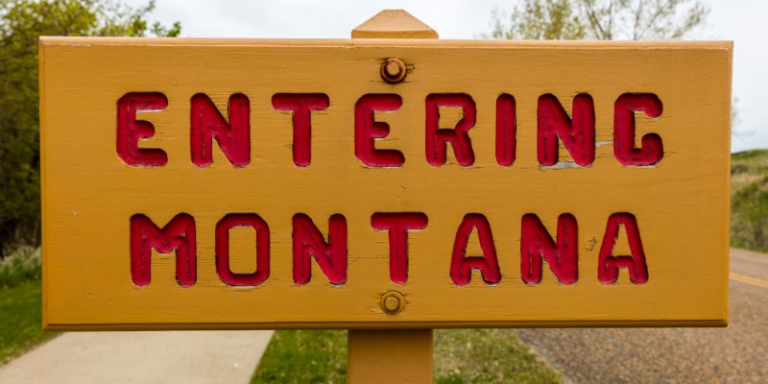Montana: The Treasure State
Enough gold and gems have been mined in Montana for it to earn the nickname Treasure State.
By: Kelli Ballard | July 7, 2020 | 463 Words

Welcome to Montana state road sign. (Photo by Visions of AmericaEducation ImagesUniversal Images Group via Getty Images)
Montana entered the Union as the 41st state on November 8, 1889. Many of the U.S. states got their names from the indigenous tribes of the region; however, Montana is a Spanish translation from “montaňa” which means “mountainous region.” This is a bit of an ironic name since the average elevation is only about 3,400 feet, the lowest of the states around the Rocky Mountains.
The first white explorers were the members of the Lewis and Clark Expedition from 1804 to 1806. Not long after that, fur trappers and traders flocked to the area, especially to collect beaver pelts. By the 1840s, however, the beaver population had dwindled, and the beaver hat had lost its popularity. So the fur trade started to die down.
In the 1860s, after gold was discovered, settlers flocked to the area searching for fortune. Plenty of other precious jewels were mined as well, giving the area one of its nicknames: Treasure State. In 1864, Montana became a territory, which further advertised it to settlers seeking new adventures and homes. Unfortunately, the surge of new settlements infringed on Native American lands causing battles and skirmishes to pop out. Perhaps the most famous in all American history was the Battle of the Little Big Horn, also known as Custer’s Last Stand, where the natives were able to win against the U.S. Army.
Battle of Little Big Horn
 In 1868, a treaty was signed between the U.S. and the Lakota people, which guaranteed the people a section of land in South Dakota. This included the Black Hills, where gold was later discovered. Gold is a mighty motivator and people began to encroach on Native land. The U.S. decided the land was too rich in the resource and tried to force the Lakota off the land. The Army was sent to remove any remaining tribes in the area.
In 1868, a treaty was signed between the U.S. and the Lakota people, which guaranteed the people a section of land in South Dakota. This included the Black Hills, where gold was later discovered. Gold is a mighty motivator and people began to encroach on Native land. The U.S. decided the land was too rich in the resource and tried to force the Lakota off the land. The Army was sent to remove any remaining tribes in the area.
Word spread of a large group of Native Americans gathering near the Little Bighorn River, so General George Custer and his men were sent to investigate and keep the tribes from advancing any further. Meanwhile, Lakota Chief Sitting Bull had a vision of a victorious battle over the white man army. He and members of several other tribes including the Dakota, Cheyenne, and Arapaho, amassed more than 2,000 warriors. Custer only had about 650 soldiers, and he split them into two groups. Custer’s group didn’t have any survivors, but the other group was rescued when reinforcements showed up.
Today, Montana is known as the Big Sky Country. It is the fourth largest state, but also the most spacious, with an average of six people per square mile. It is home to the first national park established in the nation, Yellowstone National Park, which is located in the southern part of the state and northern Wyoming.
















